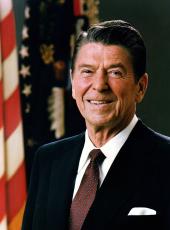Today marks the close of round five in the U.S. and Soviet nuclear and space talks in Geneva (NST). The U.S. goal in these negotiations is to obtain Soviet agreement to deep, equitable, and effectively verifiable reductions in the nuclear arsenals of the U.S. and the Soviet Union in a manner that strengthens strategic stability.
For the past 7 weeks, the U.S. negotiating team in Geneva has worked hard in pursuit of this goal by explaining and elaborating on the concrete proposals which the U.S. is offering in all three areas of these negotiations. These U.S. proposals include:
—In the strategic arms (START) negotiating group, a formula for equitable and verifiable reductions of 50 percent in offensive nuclear forces;
—In the intermediate nuclear forces (INF) negotiating group, a concrete, phased approach for eliminating the entire class of U.S. and Soviet land-based INF missiles;
—In the defense and space group, an offer to engage in a dialog on managing the transition to a more stable basis for deterrence through increased reliance on defensive systems, rather than offensive nuclear arms, and an "open laboratories" initiative to assure each side of the defensive nature of the other side's strategic defense research.
The American negotiators have presented these proposals in the spirit of last November's Geneva summit. At the summit, General Secretary Gorbachev and I promised to seek 50-percent reductions in offensive nuclear arms, appropriately applied, as well as an interim INF agreement. Much to our disappointment, until recently the Soviets have shown no interest in seriously following up at the negotiating table. In the past 2 weeks, however, the Soviet negotiators at Geneva have tabled new proposals. I am hopeful that these proposals signal the beginning of a serious Soviet effort to join with us in actually reducing offensive nuclear arms. If the Soviet Union is now genuinely seeking progress, we may have reached a turning point in our efforts to build a safer and more peaceful world. I deeply hope that this is indeed the case.
We approach these negotiations with realism and determination. While we clearly cannot accept these Soviet proposals without changes, we are studying Soviet ideas on reductions very carefully to see how they might help to move us toward our goal of deep, equitable, and verifiable arms cuts. At the same time, we believe that if progress can be made in one of the three NST negotiating areas, it should not he held up—as the Soviets are still insisting—pending agreement in another area.
We know there is much hard bargaining ahead, but for our part, the United States is determined to do everything we can to achieve these deep reductions. If recent events indicate that the Soviet Union is now ready to work together with us in this urgent endeavor, we can begin now to ensure a safer and more stable peace for future generations.
Note Larry M. Speakes, Principal Deputy Press Secretary to the President, read the statement to reporters at 10:32 a.m. in the Vista Mar Monte Room at the Sheraton Santa Barbara in California.
Ronald Reagan, Statement on the Soviet-United States Nuclear and Space Arms Negotiations Online by Gerhard Peters and John T. Woolley, The American Presidency Project https://www.presidency.ucsb.edu/node/259065

